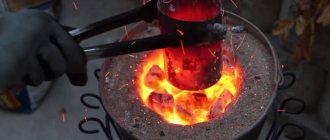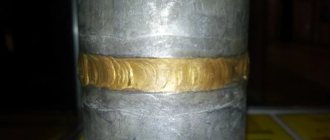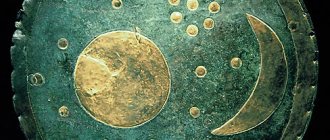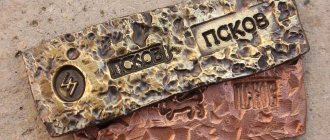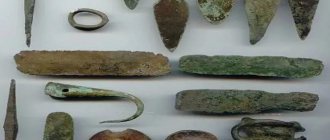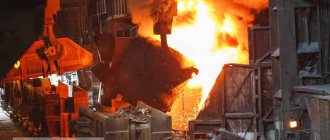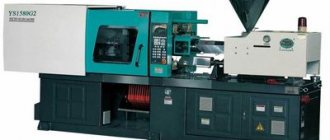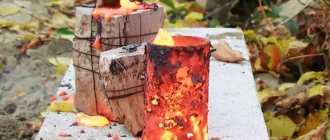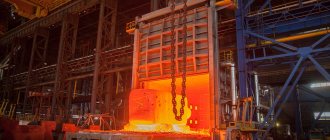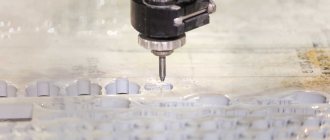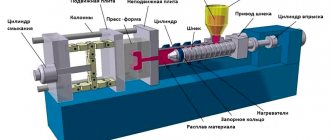Aluminum bronze
- a type of bronze in which aluminum is the main alloying metal added to copper (as opposed to ordinary bronze, where copper is alloyed with tin, or brass, where zinc is used). Aluminum bronzes of different compositions have found industrial use, but most alloys contain aluminum in amounts from 5% to 11% by weight, and the rest is copper and other alloying elements such as iron, nickel, manganese and silicon.
Chemical composition of alloys
The table below shows the compositions of several typical standard aluminum bronzes that are processed by pressure, and their designations according to GOST 18175-78[1] and ISO 428[2]. The percentage shows the proportional composition of the alloy by weight. Copper makes up the rest and is not listed in the table:
| ISO 428 grade | Alloy according to GOST 18175-78 | ||||||
| CuAl5 | BrA5 | 4,0…6,5 % | 0.5% max. | 0.8% max. | 0.5% max. | 0.5% max. | 0.4% max. |
| CuAl8 | BrA7 | 7,0…9,0 % | 0.5% max. | 0.8% max. | 0.5% max. | 0.5% max. | |
| CuAl8Fe3 | 6.5…8,5 % | 1,5…3,5 % | 1.0% max. | 0.8% max. | 0.5% max. | ||
| CuAl9Mn2 | BrAMts9―2 | 8,0…10,0 % | 1.5% max. | 0.8% max. | 1,5…3,0 % | 0.5% max. | |
| CuAl10Fe3 | BrAZh9―4 | 8,5…11,0 % | 2,0…4,0 % | 1.0% max. | 2.0% max. | 0.5% max. | |
| CuAl10Fe5Ni5 | BrAZHN10―4―4 | 8,5…11,5 % | 2,0…6,0 % | 4,0…6,0 % | 2.0% max. | 0.5% max. |
According to the chemical composition, bronzes can be tin or tin-free (special). In addition, depending on the number of alloying components, bronzes can be double or multicomponent. The main alloying components of bronze are aluminum, tin, lead, manganese, iron and other elements except zinc.
Based on the technical manufacturing process, bronzes are divided into wrought and cast bronzes.
Bronzes made from secondary non-ferrous metals are called secondary.
Tin bronzes contain, in addition to tin, phosphorus, lead and zinc as additional alloying elements. These additives improve the antifriction, mechanical and casting properties of copper-tin alloys. Tin bronzes have good corrosion resistance, sufficient strength, good casting and antifriction properties, and some of them in a deformed state have high elastic properties.
Tin-free (special) aluminum, silicon-manganese, as well as a number of other bronzes with properties close to tin, and in some cases even surpass them in some respects. This group includes beryllium bronze, the most durable copper-based alloy. After heat treatment, the hardness of beryllium bronze is >= HV 330 and the elastic limit is O 0.002 >= 6.5 kg/mm2. Chrome and cadmium bronze are heat-resistant copper alloys with high thermal and electrical conductivity.
Tin bronzes for the needs of foundry production are provided for by GOST 613-50 “Secondary foundry tin bronzes, which gives a range of quaternary and more complex alloys containing, along with tin, zinc and lead, as well as nickel. Minimum mechanical properties of castings from secondary cast tin bronzes: tensile strength O vr not lower than 15 kg/mm2, elongation o i.e. less than 4%, hardness not lower than NB = 60.
In some cases, it is possible to use tin bronzes made from starting materials with higher mechanical properties and more wear resistance during friction without lubrication.
Table 1. Chemical composition in % of secondary cast bronzes (according to GOST 613-50 and 614-50) Table 2. Tin bronzes processed by pressure according to GOST 5017-49 Table 3. Basic physical and chemical properties of tin bronzes (average composition) Table 4. Assortment and mechanical properties of semi-finished products from deformable tin bronzes Table 5. Chemical composition and mechanical properties of cast tin-free bronzes (according to GOST 493-54) Table 6. Chemical composition and types of semi-finished tin-free bronzes (according to GOST 493-54) Table 7. The main properties of tin-free standard (special) bronzes processed by pressure Table 8. Range and mechanical properties of semi-finished products from tin-free bronzes
Properties
The color of aluminum bronze is straw yellow, with a reddish tint reminiscent of the color of gold. Basic mechanical properties in the solid state: density 7500...8200 kg/m³, melting point 1040...1084 °C, Brinell hardness 55...220 kgf/mm², tensile strength 20...75 kgf/mm², relative elongation 20...75%[3 ].
Aluminum bronzes, in comparison with other bronze alloys, have greater strength and corrosion resistance [4]. These alloys exhibit low levels of surface corrosion under atmospheric conditions, low levels of oxidation at high temperatures, and low reactivity with sulfur compounds and exhaust products from internal combustion engines.
Nickel-containing tin bronzes
The addition of nickel to tin bronze gives the alloy such properties as significantly high strength characteristics, excellent ductility, good deformability, and resistance to corrosion processes. Due to the peculiarities of their structure, tin bronzes with nickel are well hardened by temperature exposure (hardening and subsequent aging).
A distinctive feature of these tin bronzes is their fatigue strength under corrosive conditions. This indicator increases when the tin content in the alloy is within 4 percent. When this threshold is exceeded, the increase in the characteristic under consideration slows down.
Application
Aluminum bronzes are most often used in equipment, where, due to their resistance to corrosion, they have an advantage over other structural materials. This should include bearings and landing gear parts in aircraft, assembly units in engines (especially for sea vessels), submerged structural elements of ship hulls, and ship propellers.
Aluminum bronze, due to its beautiful golden-yellow color and high corrosion resistance, is also sometimes used as a replacement for gold in jewelry and coins[5].
Aluminum bronzes are in greatest demand in the following areas:
- in the manufacture of equipment operated in marine conditions;
- in water supply equipment;
- in the oil and petrochemical industry (for example, for the manufacture of tools used in explosive environments);
- for the manufacture of equipment operated in corrosive environments;
- for the manufacture of decorative elements of building structures.
Aluminum bronze can be welded in an inert gas environment (argon).
Temperature treatment of tin bronzes
In order for tin bronzes to acquire the highest ductility, they are subjected to homogenization, intermediate and final annealing. First of all, homogenization annealing is performed, which is aimed at improving the homogeneity of the alloy structure and increasing the performance properties. In this case, the unaligned intermetallic phases disappear in the solid solution, and the alloy is stabilized along the chemical cross-section of the crystallites in the tin-copper workpiece. This procedure is carried out at significantly high temperatures, reaching up to 750 degrees. After such an operation, a sharp cooling process is performed.
At the next stage, tin bronzes undergo intermediate and final annealing at a temperature not exceeding 650 degrees. These actions allow you to get rid of work hardening formed as a result of cold plastic deformation processing of tin bronzes.
Notes
- GOST 18175-78 Tin-free bronzes, pressure-processable. Stamps.
- ISO 428 Wrought Copper-Aluminium Alloys - Chemical Composition And Forms of Wrought Products.
- GOST 1628-78 Bronze rods. Technical conditions.
- [www.csunitec.com/technical/MSDS/Cast%20Aluminium-Bronze%202008.pdf Material Safety Data Sheet. Aluminum Bronze material.] (English)
- [www.coins.ru/numizm/glossary/showarticle.phtml?word=bronze_al Numismatic dictionary. Aluminum bronze]
Mechanical properties of tin bronze and its applicability
| Brand | Casting method | Tensile strength σв, MPa | Relative elongation after rupture δ5, % | Hardness HB | Application area |
| Brozts12S5 | To | 206 | 5 | 60 | General purpose fittings |
| P | 176,2 | 8 | 60 | ||
| BroZTS7S5N1 | To | 206 | 5 | 60 | Parts operating in oil, steam and fresh water |
| P | 176,2 | 8 | 60 | ||
| BrO4TS7S5 | To | 176,2 | 4 | 60 | Fittings, anti-friction parts |
| P | 147 | 6 | 60 | ||
| BrO4Ts4S17 | To | 147 | 12 | 60 | Anti-friction parts |
| P | 147 | 5 | 60 | ||
| BrO5TS5S5 | To | 176,2 | 4 | 60 | Fittings, antifriction parts, bearing shells |
| P | 147 | 6 | 60 | ||
| BrO5S25 | To | 137,2 | 6 | 60 | Bimetallic plain bearings |
| P | 147 | 5 | 45 | ||
| BrOBTsbSZ | To | 176,2 | 4 | 60 | Fittings, antifriction parts, bearing shells |
| P | 147 | 6 | 60 | ||
| BrO8TS4 | To | 196 | 10 | 75 | Fittings, pipeline fittings, pumps operating in sea water |
| P | 196 | 10 | 75 | ||
| BrO10F1 | To | 245 | 3 | 90 | Friction units of fittings, highly loaded parts of screw drives, pressure and spindle nuts, worm wheel rims |
| P | 215,5 | 3 | 80 | ||
| BrO10TS2 | To | 225,5 | 10 | 75 | Fittings, anti-friction parts, bearing shells, friction parts and propeller shaft linings |
| P | 215,5 | 10 | 65 | ||
| BrO10S10 | To | 196 | 6 | 78 | Sleeve bearings operating under high pressure conditions |
Note. Conventional designation of the casting method: k - chill casting; n - sand casting
Excerpt characterizing Aluminum Bronze
- You, Dronushka, listen! - he said. - Don't tell me nothing. His Excellency Prince Andrei Nikolaich themselves ordered me to send all the people and not stay with the enemy, and there is a royal order for this. And whoever remains is a traitor to the king. Do you hear? “I’m listening,” Dron answered without raising his eyes. Alpatych was not satisfied with this answer. - Hey, Drone, this will be bad! - Alpatych said, shaking his head. - The power is yours! - Dron said sadly. - Hey, Drone, leave it! - Alpatych repeated, taking his hand out of his bosom and with a solemn gesture pointing it to the floor at Dron’s feet. “It’s not that I can see right through you, I can see right through everything three arshins below you,” he said, peering at the floor at Dron’s feet. The drone became embarrassed, glanced briefly at Alpatych and lowered his eyes again. “You leave the nonsense and tell the people to get ready to leave their houses for Moscow and prepare carts tomorrow morning for the princesses’ train, but don’t go to the meeting yourself.” Do you hear? The drone suddenly fell at his feet. - Yakov Alpatych, fire me! Take the keys from me, dismiss me for Christ's sake. - Leave it! - Alpatych said sternly. “I can see three arshins right under you,” he repeated, knowing that his skill in following bees, his knowledge of when to sow oats, and the fact that for twenty years he knew how to please the old prince had long ago gained him the reputation of a sorcerer and that his ability to see three arshins under a person is attributed to sorcerers. The drone stood up and wanted to say something, but Alpatych interrupted him: “What did you think of that?” Eh?.. What do you think? A? – What should I do with the people? - said Dron. - It completely exploded. I tell them this too... “I tell them this,” said Alpatych. - Do they drink? – he asked briefly. “I’m all worked up, Yakov Alpatych: they brought another barrel.” - So listen. I’ll go to the police officer, and you tell the people, so that they give up this, and so that there are carts. “I’m listening,” answered Dron. Yakov Alpatych did not insist any more. He had ruled the people for a long time and knew that the main way to get people to obey was to not show them any doubt that they might disobey. Having obtained from Dron the obedient “I listen with,” Yakov Alpatych was satisfied with this, although he not only doubted, but was almost sure that the carts would not be delivered without the help of a military team. And indeed, by evening the carts were not collected. In the village at the tavern there was again a meeting, and at the meeting it was necessary to drive the horses into the forest and not give out the carts. Without saying anything about this to the princess, Alpatych ordered his own luggage to be packed from those who had come from Bald Mountains and to prepare these horses for the princess’s carriages, and he himself went to the authorities. X After her father’s funeral, Princess Marya locked herself in her room and did not let anyone in. A girl came to the door to say that Alpatych had come to ask for orders to leave. (This was even before Alpatych’s conversation with Dron.) Princess Marya rose from the sofa on which she was lying and said through the closed door that she would never go anywhere and asked to be left alone. The windows of the room in which Princess Marya lay were facing west. She lay on the sofa facing the wall and, fingering the buttons on the leather pillow, saw only this pillow, and her vague thoughts were focused on one thing: she was thinking about the irreversibility of death and about that spiritual abomination of hers, which she had not known until now and which showed up during her father’s illness. She wanted, but did not dare to pray, did not dare, in the state of mind in which she was, to turn to God. She lay in this position for a long time. The sun set on the other side of the house and slanting evening rays through the open windows illuminated the room and part of the morocco pillow that Princess Marya was looking at. Her train of thoughts suddenly stopped. She unconsciously stood up, straightened her hair, stood up and went to the window, involuntarily inhaling the coolness of a clear but windy evening. “Yes, now it’s convenient for you to admire in the evening! He’s already gone, and no one will bother you,” she said to herself, and, sinking into a chair, she dropped her head onto the windowsill.
Technological properties and processing temperatures of tin bronzes
| Brand | Cutting machinability2,% | Fluidity, mm | Linear shrinkage, % | Temperature, °C | ||
| casting | hot deformation | annealing | ||||
| BrOF4-0.25 | 20 | — | 1,4 | 1250…1300 | 700… 850 | 600…650 |
| BrOF6.5-0.15 | 20 | — | — | 1150…1250 | 750… 850 | 600…700 |
| BrOF6.5-0.4 | 20 | 1170 | 1,45 | 1150…1250 | 750…770 | 600…700 |
| Br0f7-0.2 | 16 | — | — | 1170…1250 | 750…800 | 600…720 |
| BrOF8-0.3 | — | — | — | 1150…1250 | 680…750 | 600…720 |
| BrOTs4-3 | 20 | 200 | 1,45 | 1200…1250 | 750…850 | 600…700 |
| BrOTsS4-4-2.51 | 90 | 200 | 1,49 | 1150…1200 | — | 500…600 |
| BrOTsS4-4-4 | 90 | 250 | — | 1150…1200 | — | 600…700 |
